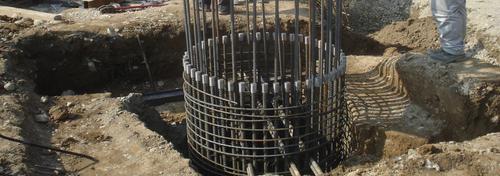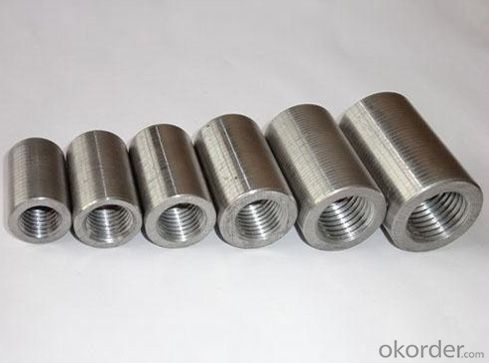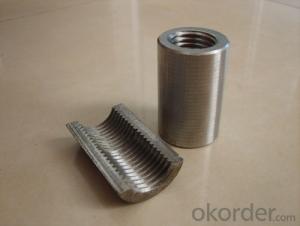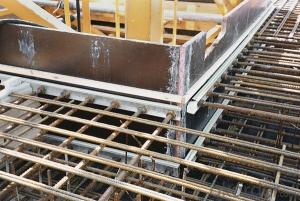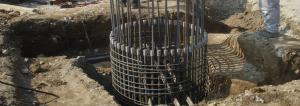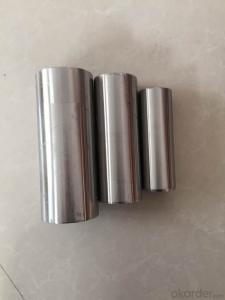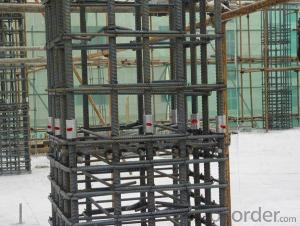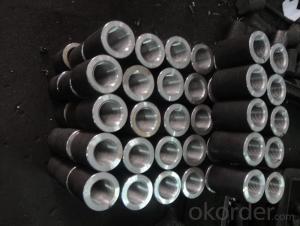Steel Coupler Rebar Iron Scaffolding Qes Scaffolding With Low Price
- Loading Port:
- Shanghai
- Payment Terms:
- TT OR LC
- Min Order Qty:
- 10000 pc
- Supply Capability:
- 10000000 pc/month
OKorder Service Pledge
OKorder Financial Service
You Might Also Like
Steel Coupler Rebar Iron Scaffolding Qes Scaffolding With Low Price
1.Description:
Lapped joints are not always an appropriate means of connecting rebar. The use of Steel Rebar Couplers can simplify the design and construction of reinforced concrete and reduce the amount of reinforcement required.
The threaded steel coupler system is designed as a threaded reinforcement connection with 100% load transmission. The steel coupler rebar connection system is suitable for both static and dynamic load transmission in construction joints.
The coupler is designed as a threaded reinforcement connection for formed construction joints. Reinforcement work is normally carried out on both sides of the construction joint using lap joints or one side is anchored. The bar lengths are based on the structural analysis requirements of the building component and are calculated from anchorage and lap lengths.
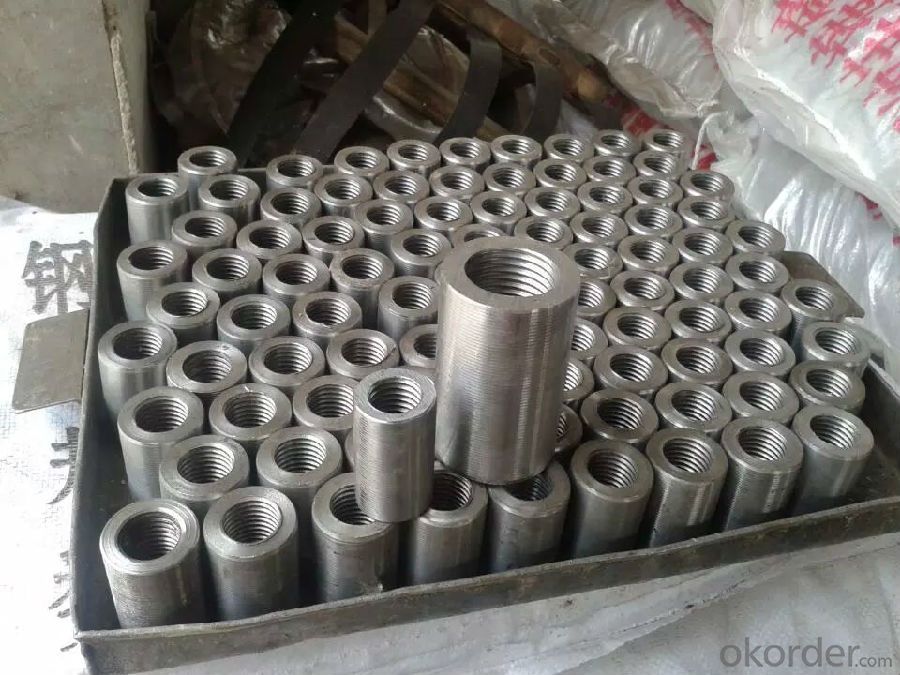

2.Advantages of Steel Coupler Rebar Lift Scaffolding Galvanized Scaffolding Tube with Low Price:
The coupler system provides the opportunity to connect rebars quickly, easily and cost effectively, even when large rebar diameters are used. This makes the steel coupler rebar range a logical extension to our rebendable CNBM reinforcement continuity system for rebars over 12 mm.
3.Available sizes of Steel Coupler Rebar Lift Scaffolding Galvanized Scaffolding Tube with Low Price:
14mm,16mm,18mm,20mm,22mmm,25mm,28mm,32mm,36mm,40mm
4.Delivery:
Delivery Term: FOB / CFR / CIF available.
Delivery Time: 15 days or less after order confirmed.
5.Why choose us?
Technical Expertise
Experienced Management
Stringent Quality Control
Exemplary Service
On-Time Delivery
Wide Product Range
Competitive Pricing
Huge branch network capable of catering worldwide
- Q: The wooden plank road construction, the steel structure and the template pavement, the railing installation all construction labor cost to want how many money? Or how much a square?
- Labor costs per ton steel production and installation: material loss making 1000 to 1300 + 3%+, 400 + 600+ installation to transport tax management fees, general standard workshop, steel 3 to 10 yuan per square metre, specifically to see the extent of the version and the difficulty
- Q: I was engaged in the patent agency, the two days of receipt of a patent application on the bridge, it is a drawing section map, the other nothing, no label no text, I am on mechanical, civil engineering drawings and utterly ignorant of ah, so simple, later on the Internet for a long time and recall ratio of patent it is unclear whether the drawings, sections of the box girder template, now the goal is clear, but a box girder template knowledge I don't know much about the Internet, did not find out what things, patent is only a few patents, I want to know more about the box girder and box girder template for example, the box girder template with cast-in-place prefabricated, full steel structure, steel wood structure, the hydraulic support system, but also ordinary (the ordinary I don't know what), etc. So, anyway, more detailed information as possible, thank you ~ ~ no more, I don't mind ah, not much, have a point with the province oh
- It also does a patent content, I think he just give you a map, is estimated to have worried about this patent is people steal it.
- Q: What are the different types of edge protections available for steel formwork?
- There are several types of edge protections available for steel formwork, including steel edge angles, timber edge fillets, plastic edge profiles, and rubber edge guards. These edge protections are used to ensure the safety of workers by preventing them from accidentally stepping off the edge of the formwork.
- Q: How does steel formwork contribute to the overall sustainability of the project?
- Steel formwork contributes to the overall sustainability of a project in several ways. Firstly, steel formwork is a durable and long-lasting material, which reduces the need for frequent replacement and minimizes waste generation. Additionally, it can be easily disassembled and reused in multiple construction projects, reducing the demand for new materials and minimizing the environmental impact. Steel formwork also provides excellent strength and stability, allowing for efficient and accurate construction, which in turn reduces construction time and energy consumption. Overall, the use of steel formwork promotes sustainable practices by reducing waste, conserving resources, and enhancing construction efficiency.
- Q: How does steel formwork handle different concrete reinforcement spacing?
- Steel formwork offers a versatile and robust solution for managing various reinforcement spacing in concrete structures. It consists of adjustable and flexible steel panels or frames, which can be customized to accommodate the specific spacing needed. The steel formwork panels possess multiple features that make them suitable for accommodating different reinforcement spacing. They come in various sizes and shapes, making it easy to adjust them to fit the desired spacing. Additionally, these panels are equipped with adjustable clamps or connectors, ensuring secure joining and providing stability and support for the concrete. When it comes to achieving the specific reinforcement spacing, steel formwork can be easily adapted. The steel panels can be positioned and aligned to create the desired spacing for the reinforcement bars. This can be achieved by adjusting the panels horizontally or vertically to meet the required distance between the bars. Moreover, steel formwork offers the necessary strength and durability to withstand the pressure exerted by the concrete during pouring and curing. This guarantees the formwork's integrity and stability, even when dealing with different reinforcement spacing. To sum up, steel formwork is well-suited for managing various reinforcement spacing in concrete structures. Its adjustable and flexible design allows for customization to meet the specific project requirements. The strength and durability of steel formwork ensure effective support for the concrete and maintain stability throughout the construction process.
- Q: What are the weight limitations of steel formwork?
- The weight limitations of steel formwork depend on various factors such as the specific type of steel used, the design and structure of the formwork, and the load-bearing capacity of the supporting structure. However, in general, steel formwork can typically handle heavy loads ranging from several hundred kilograms to several tonnes per square meter. It is important to consult the manufacturer's specifications and engineering professionals to determine the exact weight limitations for a specific steel formwork system.
- Q: What are the different types of joints used with steel formwork?
- There are several types of joints that are commonly used with steel formwork in construction projects. These joints are designed to ensure stability, strength, and ease of assembly and disassembly. Some of the most commonly used joints include: 1. Butt joint: This is a simple joint where two steel formwork sections are connected by placing their edges together. It is commonly used for straight sections of formwork. 2. Lap joint: In a lap joint, one formwork section overlaps another, creating a strong connection. This joint is often used for longer sections of formwork to provide additional strength. 3. Clamped joint: A clamped joint involves using clamps or bolts to secure the formwork sections together. This type of joint allows for easy adjustment and repositioning of the formwork. 4. Wedge joint: A wedge joint is commonly used to connect vertical and horizontal formwork sections. It involves inserting a wedge-shaped piece into a slot to create a secure connection. 5. Flanged joint: A flanged joint is created by using flanges or plates on the formwork sections that overlap and are bolted together. This joint provides a strong connection and is often used for large and heavy formwork components. 6. Pin joint: A pin joint involves using pins or dowels to connect formwork sections together. This type of joint allows for quick and easy assembly and disassembly of the formwork. It is important to select the appropriate joint type based on the specific requirements of the construction project. The choice of joint will depend on factors such as the formwork design, load-bearing capacity, ease of assembly, and required reusability.
- Q: Can steel formwork be used in high-rise construction projects?
- Indeed, high-rise construction projects can benefit from the utilization of steel formwork. With its versatility and durability, steel formwork proves to be an excellent choice for constructing concrete structures, especially in the realm of high-rise buildings. This option boasts various advantages, such as its exceptional strength, remarkable dimensional stability, and its ability to endure heavy loads and pressure. Moreover, steel formwork guarantees a smooth finish to the concrete surface and promotes environmental sustainability by allowing for easy reusability. Consequently, this minimizes material wastage and effectively reduces project costs. Furthermore, the adaptability of steel formwork systems enables customization to meet the specific requirements of high-rise construction projects, ultimately ensuring efficient and precise construction processes.
- Q: What are the limitations of using steel formwork?
- Some limitations of using steel formwork include its high cost compared to other types of formwork materials, its heavy weight which makes it difficult to move and handle, and its susceptibility to corrosion if not properly maintained. Additionally, steel formwork requires skilled labor for its installation and removal, which can increase project costs.
- Q: What are the considerations when designing steel formwork for underground utilities?
- When designing steel formwork for underground utilities, there are several important considerations to keep in mind. Firstly, the formwork must be able to withstand the pressure and weight of the surrounding soil and any potential water infiltration. It is crucial to ensure that the formwork is strong and stable enough to prevent any collapse or deformation during and after the pouring of concrete. Secondly, the formwork design should allow for easy installation and removal. Accessibility and maneuverability are key factors, as underground utilities can often be located in tight spaces or areas with limited access. The formwork should be designed in such a way that it can be easily assembled and disassembled without causing damage to the surrounding infrastructure. Additionally, the formwork needs to be corrosion-resistant to withstand the potentially corrosive environment of underground utilities. Steel formwork should be properly coated or treated to prevent rust and deterioration over time. Lastly, consideration should be given to the formwork's compatibility with other construction materials and techniques. The design should integrate well with other components of the underground utility system and accommodate any necessary connections or interfaces. Overall, the design of steel formwork for underground utilities requires careful attention to strength, stability, accessibility, corrosion resistance, and compatibility with other construction elements.
Send your message to us
Steel Coupler Rebar Iron Scaffolding Qes Scaffolding With Low Price
- Loading Port:
- Shanghai
- Payment Terms:
- TT OR LC
- Min Order Qty:
- 10000 pc
- Supply Capability:
- 10000000 pc/month
OKorder Service Pledge
OKorder Financial Service
Similar products
Hot products
Hot Searches


